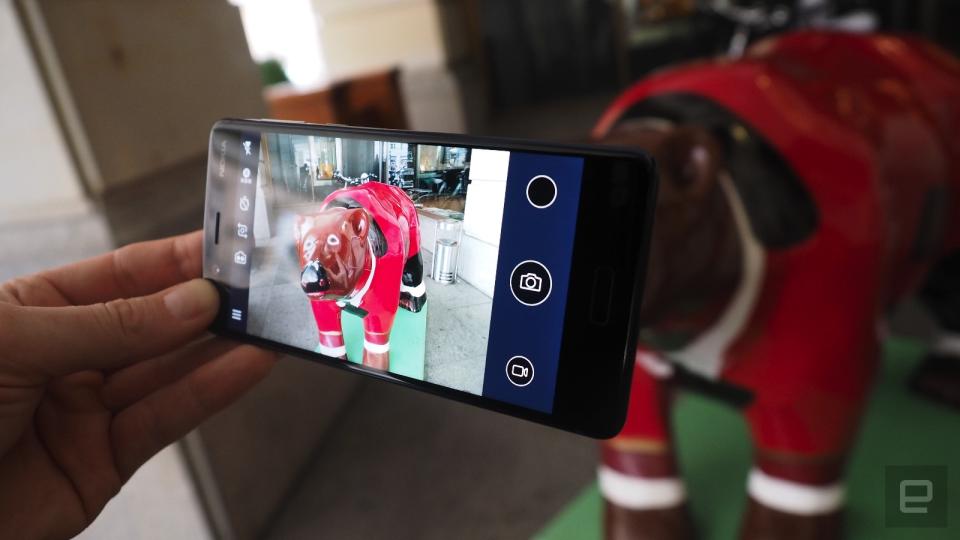Nokia 8's dual-camera is good, but rival phones offer more
It doesn't do justice to the label's imaging heritage.
The Nokia 8 broke cover in the run-up to IFA 2017, so while it wasn't officially launched at the show in Germany, it's one of several phones vying for your cash ahead of a certain company's next phone. It's the most accomplished Android phone that Nokia has made, but with Nokia's tradition of pushing mobile-imaging forward, how does it fare against the mighty cameraphone competition in 2017? We took an early device around Berlin to see how it fared.

So has Nokia kept up? It's certainly tried to. Pairing two camera sensors together is the 2017 thing to do with flagship phones, and with the Nokia 9, it's a combination of two 13-megapixel sensors. One deals in monochrome; the other, in color. That monochrome sensor helps the phone to deal with low-light and other difficult shooting environments, while also offering the opportunity for true black-and-white photography -- right from the source.
My monochrome shots turned to be some of my favorite images -- it was a feature that several editors at Engadget also loved on Huawei's P10. However, it doesn't quite pack the punch of that phone, which used a mightier 20-megapixel sensor -- that's seven megapixels beyond the Nokia handset, and so images are a little flatter, a little less textured.

So how about "twin" mode, which combines the input from the two sensors all at once? They're good, but not stellar. Damning with faint praise perhaps, but while some pictures came out wonderfully, I was often disappointed by either the dynamic range (blue skies would wash out anything else in the frame) or underperforming focus. Many of the test shots you see here are my "best" ones: 13 megapixels should be more than enough for crisp shots, but the Nokia 8, despite those Zeiss lenses, delivered merely good images — not great. Color accuracy was generally good, but I felt many of my images were a little muted compared to reality, even with HDR mode turned on. A sunny day in Berlin is the chance for a smartphone to shine, but my photos don't seem to show that. This was further compounded when comparing the results against LG's V30 in similar conditions.

Also, after being spoiled with the camera-app control options of Nokia's Lumia phones years ago, the lack of true manual controls and tweaks was also disappointing. There are three focus modes: include center-weighted, evaluative -- which generally involves face detection -- and old-fashioned auto, while there's similarly limited options for focal range photography. Macro, infinite distance and auto are your three only options. And that software-driven bokeh mode that we're seeing on most smartphones with two lenses? The Nokia 8's interpretation of it is just not that good. It typically smeared objects outside the main area of focus and usually neglected to take into account the details of, say, the stag statue antlers.
That's not to say there's nothing to play with inside the camera app. The simple control UI includes the ability to combine the front facing camera with the rear-facing duo for simultaneous photos and video. This is what a "bothie" is made of.
The good parts: The cameras on both the front and back use the same resolution, so your images don't look particularly uneven. There were, however, times when the front-facing camera struggled with changes in lighting. The biggest problem was the physical challenge of lining up what you're trying to capture. I took some "bothie" video as we drove around the Berlin Victory Column during the photography testing, and it was hard to balance capturing both the building and myself in the back of the car. You could say that's fine for rough-and-ready live broadcasts, but it's difficult to make anything look particularly good. A wider-angle lens on the front-facing camera would have alleviated things.

And about that live-casting: Nokia added the ability to live-stream directly from the camera app to YouTube or Facebook -- which is a smart idea. However, when trying it out, I barely seemed to notice that hyped-up Nokia OZO-branded audio recording. Despite promises of 360-degree directional audio and three microphones embedded inside the phone, the quality was pretty rough. My voice blasted out on Facebook, while video compression wrecked the quality of the video. This isn't completely the fault of the Nokia 8: Phone signal quality and Facebook's own compression tricks are all involved. But the bottom line is that I don't want to share something that sounds grating and looks muddy. What's the point in that?
Another issue I had was the delay in switching between the two sensors on the back of the Nokia 8. This was a problem with several of the first wave of dual-lens camera phones last year, but most have figured out how to speed up this transition. We got to test this Nokia 8 ahead of its retail launch in Europe, so there is the chance that the company can tweak some of these issues through software updates. At this point, there's certainly plenty for the engineers to work on.
Follow all the latest news from IFA 2017 here!





































